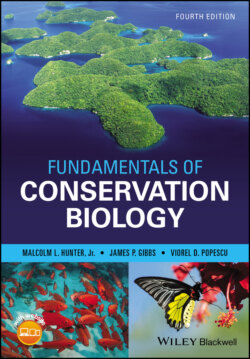Читать книгу Fundamentals of Conservation Biology - Malcolm L. Hunter Jr. - Страница 86
The Species Richness of Ecosystems
ОглавлениеLying just below the diversity–stability question is a more fundamental issue: why are some ecosystems more diverse than others? Even the most casual observer of nature realizes that a tropical coral reef is extraordinarily more diverse than an alpine pond, but why? Examining images (compare Figs 2.1, 4.5, 4.8, and 4.10) may show the general pattern, but what underlies this? What factors shape the rates at which species accumulate in an ecosystem (through colonization or speciation) or disappear from an ecosystem (through local or global extinction)? Once again, there is no simple, universally accepted answer, but here is a brief overview of some of the ideas that have been proposed. (See Rosenzweig 1995 ; Lomolino et al. 2010; Brown 2014 ; Huston 2014 for further details.)
Life flourishes in warm, moist places; think about tropical forests, or consider what would happen to a bowl of egg salad left in a picnic basket for a couple of summer days. This simple observation has been supported in the scientific literature by many positive correlations between species richness and temperature, precipitation, energy flux, and complex metrics such as potential evapotranspiration. There are some exceptions to this general pattern and, obviously, the availability of water is not an issue in aquatic ecosystems. Nevertheless, the overall pattern is clear, and it makes sense: more species should be able to evolve and persist in places with adequate water and energy where they can channel their resources into growth and reproduction rather than a struggle to cope with stress. This may be especially true where water and energy are available year round (e.g. many tropical ecosystems) versus very seasonal environments with long periods of cold or drought.
Interestingly, while high levels of disturbance limit diversity (e.g. on the slopes of an active volcano), moderate levels of disturbance may actually promote species diversity. For example, a forest that is subject to occasional windstorms or ground fires may harbor more species than a forest that is rarely affected by disturbance. Occasional flooding tends to enrich river ecosystems and their shore. There are two possible explanations here. First, occasional disturbances are likely to prevent a few species from dominating the ecosystem. (In this context, predation and disease may also be considered forms of disturbance that limit dominance by a few species; recall from Chapter 3 how predation by the purple sea star leads to richer intertidal communities.) In other words, the absence of predators, disease, or disturbance may allow a few species to prosper with minimal competition, and, while such ecosystems may be highly productive (e.g. a salt marsh), they will be species‐poor overall. Second, disturbances are usually patchy, and this will generate spatial heterogeneity that allows many species to coexist. For example, a forest that is a mosaic of different age patches created by small wind‐throw events would have all the species associated with different stages of ecological succession, while an undisturbed forest would have just those species associated with a late‐successional stage (i.e. the disturbed forest would exhibit beta diversity among the different patches). Of course, many ecosystems have heterogeneous environments with or without the patchiness of disturbances, and this is also an important source of niches for additional species. For example, an ecosystem that has an array of substrates ranging from clay to boulders will support more species than one that is covered by only clay. Similarly, the vertical dimension of forests and aquatic ecosystems is a form of spatial heterogeneity that adds opportunities for many species.
One simple explanation for why species richness varies among ecosystems is their size. Not surprisingly, more species can fit into a large ecosystem than a small one. There are many reasons for this, which we will discuss in Chapter 8 in the section on fragmentation. That discussion will also cover isolation, another factor that limits species richness by curtailing colonization, especially on islands. Time may also be a factor. Notably, the species richness of the tropics may be partly related to having long periods available for coevolution to generate new life‐forms without being bulldozed by glaciers, as has happened repeatedly at higher latitudes.
Finally, we need to recognize that species richness probably operates in a positive‐feedback loop, a “snowballing effect” in more colloquial language, to further increase the diversity of species‐rich ecosystems. Compare two ecosystems, one with 50 species of plants and the other with 200. The latter is likely to support a much wider spectrum of herbivores, pollinators, parasites, pathogens, and so on (Haddad et al. 2009; Lin et al. 2015). In other words, species beget species.
To summarize, the primary driver of species richness is the physical environment, especially how big, warm, and wet it is and how much it varies in space and time because of disturbances and other factors. Secondarily, the dominant species in the system (plants in terrestrial systems and a mixture of plants, algae, corals, and more in aquatic systems) shape diversity by enhancing spatial heterogeneity and providing the basis of a food web. Ultimately, every species may play some role, if only as food for its suite of predators, parasites, and pathogens.
